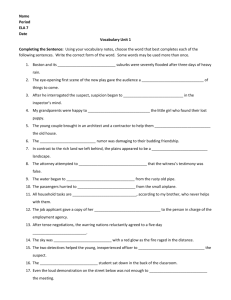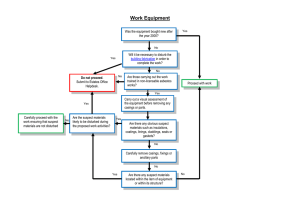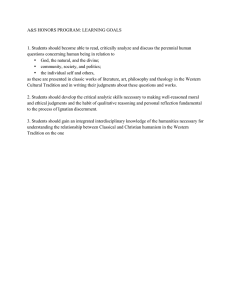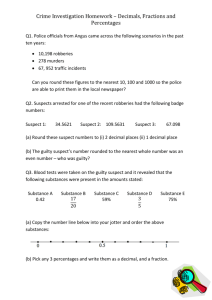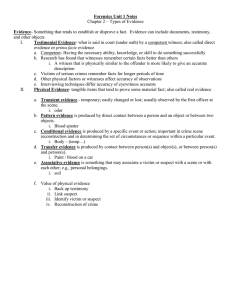The impact of discredited evidence
advertisement
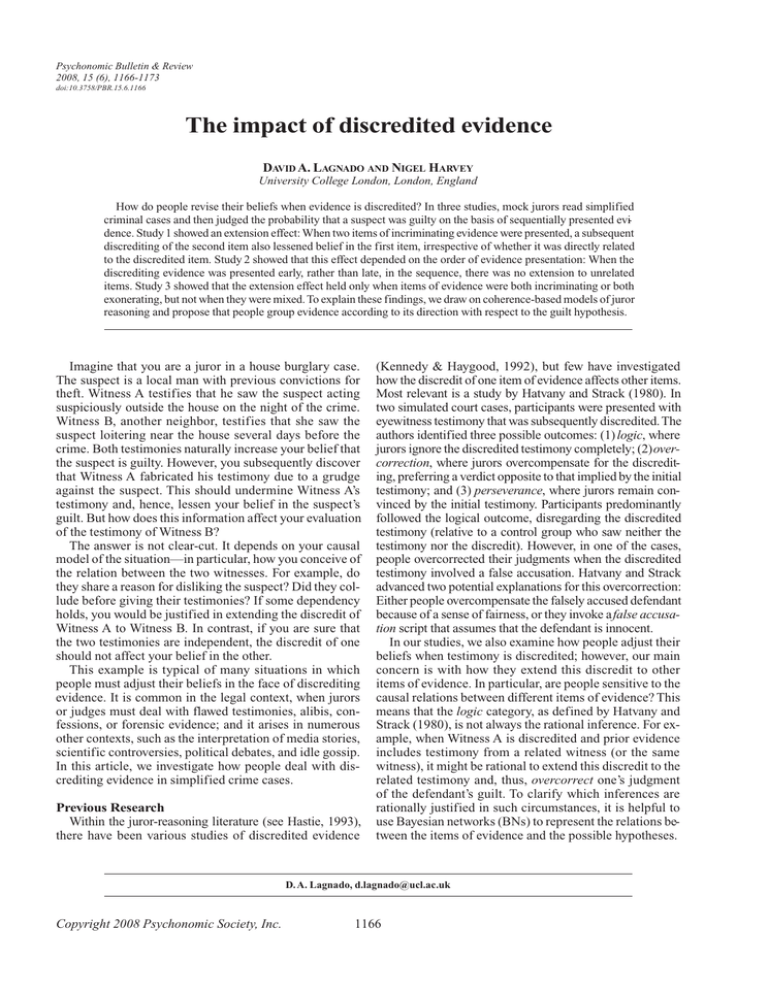
Psychonomic Bulletin & Review 2008, 15 (6), 1166-1173 doi:10.3758/PBR.15.6.1166 The impact of discredited evidence DAVID A. LAGNADO AND NIGEL HARVEY University College London, London, England How do people revise their beliefs when evidence is discredited? In three studies, mock jurors read simplified criminal cases and then judged the probability that a suspect was guilty on the basis of sequentially presented evidence. Study 1 showed an extension effect: When two items of incriminating evidence were presented, a subsequent discrediting of the second item also lessened belief in the first item, irrespective of whether it was directly related to the discredited item. Study 2 showed that this effect depended on the order of evidence presentation: When the discrediting evidence was presented early, rather than late, in the sequence, there was no extension to unrelated items. Study 3 showed that the extension effect held only when items of evidence were both incriminating or both exonerating, but not when they were mixed. To explain these findings, we draw on coherence-based models of juror reasoning and propose that people group evidence according to its direction with respect to the guilt hypothesis. Imagine that you are a juror in a house burglary case. The suspect is a local man with previous convictions for theft. Witness A testifies that he saw the suspect acting suspiciously outside the house on the night of the crime. Witness B, another neighbor, testifies that she saw the suspect loitering near the house several days before the crime. Both testimonies naturally increase your belief that the suspect is guilty. However, you subsequently discover that Witness A fabricated his testimony due to a grudge against the suspect. This should undermine Witness A’s testimony and, hence, lessen your belief in the suspect’s guilt. But how does this information affect your evaluation of the testimony of Witness B? The answer is not clear-cut. It depends on your causal model of the situation—in particular, how you conceive of the relation between the two witnesses. For example, do they share a reason for disliking the suspect? Did they collude before giving their testimonies? If some dependency holds, you would be justified in extending the discredit of Witness A to Witness B. In contrast, if you are sure that the two testimonies are independent, the discredit of one should not affect your belief in the other. This example is typical of many situations in which people must adjust their beliefs in the face of discrediting evidence. It is common in the legal context, when jurors or judges must deal with flawed testimonies, alibis, confessions, or forensic evidence; and it arises in numerous other contexts, such as the interpretation of media stories, scientific controversies, political debates, and idle gossip. In this article, we investigate how people deal with discrediting evidence in simplified crime cases. Previous Research Within the juror-reasoning literature (see Hastie, 1993), there have been various studies of discredited evidence (Kennedy & Haygood, 1992), but few have investigated how the discredit of one item of evidence affects other items. Most relevant is a study by Hatvany and Strack (1980). In two simulated court cases, participants were presented with eyewitness testimony that was subsequently discredited. The authors identified three possible outcomes: (1) logic, where jurors ignore the discredited testimony completely; (2) overcorrection, where jurors overcompensate for the discrediting, preferring a verdict opposite to that implied by the initial testimony; and (3) perseverance, where jurors remain convinced by the initial testimony. Participants predominantly followed the logical outcome, disregarding the discredited testimony (relative to a control group who saw neither the testimony nor the discredit). However, in one of the cases, people overcorrected their judgments when the discredited testimony involved a false accusation. Hatvany and Strack advanced two potential explanations for this overcorrection: Either people overcompensate the falsely accused defendant because of a sense of fairness, or they invoke a false accusation script that assumes that the defendant is innocent. In our studies, we also examine how people adjust their beliefs when testimony is discredited; however, our main concern is with how they extend this discredit to other items of evidence. In particular, are people sensitive to the causal relations between different items of evidence? This means that the logic category, as defined by Hatvany and Strack (1980), is not always the rational inference. For example, when Witness A is discredited and prior evidence includes testimony from a related witness (or the same witness), it might be rational to extend this discredit to the related testimony and, thus, overcorrect one’s judgment of the defendant’s guilt. To clarify which inferences are rationally justified in such circumstances, it is helpful to use Bayesian networks (BNs) to represent the relations between the items of evidence and the possible hypotheses. D. A. Lagnado, d.lagnado@ucl.ac.uk Copyright 2008 Psychonomic Society, Inc. 1166 THE IMPACT OF DISCREDITED EVIDENCE Formal Models of Evidential Reasoning BNs provide a normative framework for evidential reasoning (Pearl, 1988) and have recently been applied in legal and forensic contexts. They represent the complex interrelations between bodies of evidence and hypotheses and allow inferences to be drawn about target hypotheses on the basis of observed evidence. The graphical component of a BN comprises a set of nodes that represent variables of interest (e.g., crime hypotheses, evidence statements, etc.) and a set of directed links between these variables that represent causal or evidential relations. This yields a directed graph that compactly represents the probabilistic relations between the variables (in particular, the conditional and unconditional dependencies). The graph can be used to read off which items of evidence are relevant to each other or to particular hypotheses. In addition, BNs have a quantitative component, consisting of conditional probability distributions for each variable in the graph. For present purposes, we will focus just on the graphical component, since it captures the qualitative notions of relevance and causal dependency that are critical in legal inquiry. Graphs for the kinds of crime scenarios used in our studies are depicted in Figure 1. Panel A represents a scenario in which the suspect is confronted with two independent pieces of incriminating evidence: The forensic lab reports that footprints found at the crime scene match the suspect’s (Evidence A), and a witness testifies that he or she saw the suspect at the crime scene (Evidence B). The witness’s testimony is subsequently discredited (Discredit C). The absence of a link between the two items of incriminating evidence (and no other variable linking the two) implies that the discredit of the witness should not affect the forensic evidence. Panel B represents a different scenario in which two pieces of evidence are interdependent: Witness A has colluded with Witness B in their testimony about the suspect. The link between A and B implies that the discredit of one should affect evaluation of the evidence given by the other. More complex networks can be drawn up for further variations (e.g., when the same witness makes two different statements); the key point is that the rationality of inferences after the discrediting of one item depends on A Evidence A the presumed causal model. This means that the classification used by Hatvany and Strack (1980) will not always hold; sometimes the logical response can result in overcorrection. Descriptive Models of Jury Decision Making How do people actually integrate different items of evidence to reach a verdict? Three models of juror decision making dominate the psychological literature. The belief adjustment model (Hogarth & Einhorn, 1992) assumes that people start with an initial opinion based on their background information. When a new item of evidence is received, it is encoded as positive or negative in relation to the guilt hypothesis, weighted according to its judged strength, and then additively combined with their prior belief. This process is iterated until all items of evidence are integrated and a final degree of belief is reached. The belief adjustment model is an online model: It sequentially processes new items of evidence, rather than performing a global evaluation of all items together. This avoids heavy computational or storage demands. However, it can lead to order effects, where the same set of evidence yields different final judgments, depending on the order in which items are presented. In particular, with mixed evidence (i.e., items both for and against the guilt hypothesis), the model predicts a recency effect, whereby the last piece of evidence presented is overweighted. Thus, the model has a simple explanation for the overcorrection observed in Hatvany and Strack (1980). The discrediting evidence is overweighted because it occurs last. This model also assumes that items of evidence are independent and, thus, does not consider possible causal relations between items. As Hogarth and Einhorn (1992) acknowledged, this is a serious shortcoming when the model is applied to complex bodies of evidence. In contrast, the story model (Pennington & Hastie, 1992) places strong emphasis on the interrelations between items of evidence. People construct stories to make sense of the evidence presented in court, and these narratives determine their predeliberation verdicts. Stories typically involve networks of causal relations between events; they draw on the evidence presented in the case, as well as on prior assumptions and common sense knowledge. B Guilt Evidence B Discredit C 1167 Guilt Evidence A Evidence B Discredit C Figure 1. Graphs showing relations between evidence and guilt hypothesis. (A) Scenario with independent items of evidence. (B) Scenario with dependent items. 1168 LAGNADO AND HARVEY According to this model, people make holistic judgments on the basis of their causal interpretation of the evidence, and this can involve constructive sense-making processes. Applied to the case of discrediting, the story model is akin to Hatvany and Strack’s (1980) script-based explanation: In the light of the discredited testimony, people invoke a false accusation story, and this leads to overcorrection. The story model has garnered broad empirical support but remains vaguely specified with respect to underlying cognitive processes and mechanisms. Moreover, Pennington and Hastie (1992) argued that the model applies only to global judgments (those made once all the evidence has been processed). In the case of online judgments, people are supposed to revert to a simpler belief adjustment model. Coherence-based models (Simon & Holyoak, 2002; Thagard, 2000) provide a process-level account of legal reasoning, derived from earlier theories of cognitive consistency. The key claims are that the mind strives for consistency in its representations and that judgments emerge from an interactive process that seeks the most coherent overall representation of the decision problem. This process can lead to bidirectional reasoning; inference flows not only from evidence to conclusions, but also from emerging conclusions back to the evidence. Thus, evidence can be reevaluated to fit with emerging hypotheses (cf. Carlson & Russo, 2001). This coherence-based model contrasts with the belief adjustment model (which does not reevaluate evidence) and with Bayesian models that clamp evidence variables. Like the story model, the coherence model describes holistic judgments based on complex bodies of interrelated evidence and accentuates the constructive nature of human reasoning. In addition, it specifies the computational processes that underpin these judgments and predicts possible biases due to bidirectional reasoning and the preference for coherence representations (perhaps at the cost of biased interpretations of the evidence). With regard to the effect of discredited evidence, coherence-based models can flexibly account for perseverance or overcorrection. The goal of consistency could lead to the underweighting of the discrediting information in order to maintain the guilt hypothesis or to an extreme shift to the innocent hypothesis in order to assimilate the discredit. This will depend on the relative coherence of the competing representations. Overview of Studies This article explores the conditions under which people extend the discrediting of one item of evidence to other items. Participants read simplified criminal cases and judged the probability that a suspect was guilty on the basis of sequentially presented evidence. In Study 1, two items of incriminating evidence were given, followed by information that discredited the second item of evidence. The key question was how the discrediting of the second item would affect people’s beliefs about the first item. On a normative BN account, people should extend the discredit only when the two items were related in some way. To test this, we manipulated the degree of relatedness between the items of evidence: Evidence came from the same source (e.g., two statements from the same neighbor), similar sources (e.g., two statements from different neighbors), or different sources (e.g., one statement and one blood test). On the normative account, people should extend the discredit when the two items of evidence come from the same source, but not when they come from different sources. The prediction for the similar condition is underdetermined but should lie somewhere in between these two extremes. The three descriptive models outlined above make the following predictions. The belief adjustment model predicts no substantial difference between the relatedness conditions, because it ignores interrelations between items of evidence. It also predicts overweighting of the final item and, thus, potential overcorrection in all three conditions. The story model takes causal relations between items into account and, therefore, predicts differences in the relatedness conditions; in particular, like the formal model, it predicts that the discredit is more likely to be extended in the same, rather than in the different, condition. The coherence-based model’s focus on interrelations between items suggests an influence of relatedness akin to that in the story model. However, the drive for consistency implies possible biases. It could lead to either perseverance (e.g., maintain consistency by ignoring the discredit) or overcorrection (e.g., maintain consistency by extending the discredit to the other item). STUDY 1 Method Participants and Apparatus. Twenty-four undergraduates from University College London (UCL) were paid £3 to participate. The experiment was run on computers in individual testing rooms. Materials. Nine different crime scenarios were constructed. Each scenario began with background details about the crime and the chief suspect. This background information was followed with two pieces of evidence that incriminated the suspect and one item that discredited the second piece of evidence. Three variants of these items were generated for each crime scenario, corresponding to three levels of relatedness: same, similar, and different (see Table 1 for examples of each condition). Procedure. Each participant was presented with nine different crime problems (three same, three similar, and three different). For each problem, the participants first read the background story and then gave their baseline judgment about the guilt of the suspect (on a rating scale from 0 to 100, with 0 definitely innocent, 50 as likely innocent as guilty, and 100 definitely guilty). The participants then read the first piece of evidence and again rated the probability of guilt. This was repeated for the second item of evidence and then for the discrediting evidence. The participants thus gave four sequential probability judgments in each problem (baseline, Stage 1, Stage 2, final). Results Mean guilt judgments at each stage are shown in Figure 2. The key comparison is whether the final judgments are different from the Stage 1 judgments. If they are not different, the discrediting information discounts the second item of evidence alone. However, in all three relatedness conditions, the final judgments were significantly THE IMPACT OF DISCREDITED EVIDENCE 1169 Table 1 Sample Crime Scenario Background: House burglary in a wealthy area of the district. Suspect is a local man with previous convictions for theft. Evidence 1 Evidence 2 Discredit (of 2) Condition Same Similar Different Neighbor said he saw suspect Neighbor 1 said he saw suspect Lab tests reveal that footprints loitering in area a few days loitering in area a few days beat the crime scene match the before crime. fore crime. suspect’s. Same neighbor said he saw Neighbor 2 said he saw suspect Neighbor said he saw suspect suspect outside house on night outside house on night of crime. outside house on night of crime. of crime. Neighbor is lying because of a long-standing grudge against the suspect. lower than those at Stage 1 [same, t(23) 3.74, p .05; similar, t(23) 2.71, p .05; different, t(23) 3.13, p .05]. The magnitudes of the differences between Stage 1 and the final stage did not differ between conditions. These results suggest that the participants extended the discredit of Item 2 to Item 1 irrespective of the causal relations between these items. For example, when they discovered that one witness was lying, they discounted not only the testimony of a related witness, but also an unrelated piece of forensic evidence. This pattern of judgments seems to rule out both the normative BN model and the story model. The belief adjustment model gives the simplest explanation: The final judgments were lower than those at Stage 1 because the discrediting information was presented last and was, therefore, overweighted. STUDY 2 Probability of Guilt The belief adjustment model holds that later items are overweighted, relative to earlier items. To further test this explanation of the results from Study 1, we varied the order in which evidence was presented. Two orders were used: (1) the late condition, in which the discredit was the final item, as in Study 1; (2) the early condition, in which the discredit was presented after the first item of evidence but before the second item. The belief adjustment model 100 90 80 70 60 50 40 30 20 10 0 Different Similar Same Baseline Stage 1 Stage 2 Final would predict an order effect: The final guilt judgment in the late condition should be lower than that in the early condition. It also would predict no effect of relatedness on these judgments. The BN model and the story model would predict no order effect and an effect of relatedness in both conditions. Method Participants. Forty-two undergraduates from UCL participated in the study. Procedure and Materials. The procedure and materials were identical to those in Study 1, except that the participants read four crime scenarios and the order of presentation (late vs. early) was crossed with two levels of relatedness (same or different). Results Mean guilt judgments for the late and early conditions are shown in Figure 3. In the late condition, the findings in Study 1 were replicated, with the final guilt judgments being significantly lower than those at Stage 1, irrespective of relatedness [same condition, t(41) 3.41, p .01; different, t(41) 2.89, p .01]. Moreover, there was no significant difference between the final judgments in the same (M 50.1) and the different (M 56.3) conditions [t(41) 1.67, n.s.]. The early condition showed a different pattern of judgments, with the final judgments in the different condition (M 69.81) significantly higher than those in the same condition (M 48.8) [t(41) 5.67, p .001]. To further explore this order effect, a 2 2 ANOVA was conducted on the final judgments. This revealed main effects of relatedness [F(1,41) 26.81, p .001] and order [F(1,41) 5.48, p .05] and a significant interaction [F(1,41) 6.20, p .05]. Paired comparisons showed no difference between late (M 50.1) and early (M 48.8) in the same condition [t(41) 0.35, n.s.] but a significant difference between late (M 56.3) and early (M 69.8) in the different condition [t(41) 3.09, p .01]. This pattern is inconsistent with the belief adjustment model, which predicts order effects irrespective of relatedness, and is inconsistent with both the BN and the story models, which predict no order effects.1 Evidence Figure 2. Mean guilt judgments in Study 1. Baseline, judgment before any evidence; Stage 1, judgment after the first item of evidence; Stage 2, judgment after the second item of evidence; Final, judgment after discredit of the second item of evidence. STUDY 3 The results from Studies 1 and 2 are difficult to explain on the basis of either the belief adjustment or the 1170 LAGNADO AND HARVEY B Late Different Same Probability of Guilt Probability of Guilt A 100 90 80 70 60 50 40 30 20 10 0 Baseline Stage 1 Stage 2 Final Early 100 90 80 70 60 50 40 30 20 10 0 Different Same Baseline Stage 1 Stage 2 Final Evidence Evidence Figure 3. (A) Mean guilt judgments in the late condition in Study 2. Judgment stages were the same as those in Study 1. (B) Mean guilt judgments in the early condition in Study 2. Stage 1, judgment after the first item; Stage 2, judgment after discredit of the first item; Final, judgment after the second item. story model. However, coherence-based approaches suggest a potential explanation. These models assume that the mind strives for the most coherent representation of the decision problem. In particular, when evidential elements are positively constrained (cohere with each other), people “will want them to either be both accepted or both rejected” (Thagard, 2000, p. 18). We propose that people group evidence as positive or negative, relative to the guilt hypothesis. These two groupings will compete with each other, but the within-group elements will mutually cohere, irrespective of the exact causal relations between them. For example, in the late condition, participants receive items A and B and group these as positive evidence against the suspect (see Figure 4). The two items cohere because both of them are incriminating. When participants receive information C, which discredits B, this discredit is extended to item A, due to the prior grouping. The mutual coherence between A and B, and C’s subsequent discredit of B, means that A and B are both undermined. In the early condition, participants receive item B first, which is then discredited by C. When they receive A, this is not grouped with B (which has been discredited) and, Late Evidence A thus, is discredited only if C applies to it directly. This account explains the overextension of discrediting in the late condition and the sensitivity to causal relatedness in the early condition. To explore this proposal, Study 3 introduced exonerating as well as incriminating evidence. Does the extension effect occur only with evidence that shares the same direction, or also with mixed evidence? The grouping hypothesis predicts that coherent groupings will emerge only with elements that share the same direction (cf. Heider, 1946) and, therefore, that the discredit will not be extended with mixed evidence items (e.g., when an incriminating witness testimony is discredited, an exonerating witness testimony will not also be undermined). To test this prediction, we constructed four evidence conditions: (1) two incriminating items (A, B) followed by discredit of B; (2) two exonerating items (A, B), followed by discredit of B; (3) one incriminating and one exonerating item (A, B), followed by discredit of B; (4) one exonerating and one incriminating item (A, B), followed by discredit of B. Thus, there were two nonmixed conditions (1 and 2) and two mixed Early Guilt Evidence B Discredit C Guilt Evidence B Evidence A Discredit C Figure 4. Effect of grouping on discrediting. In the late condition, grouping of A and B leads to overextension of Discredit C from B to A; in the early condition, no grouping occurs, so Discredit C is restricted to causally related evidence. THE IMPACT OF DISCREDITED EVIDENCE 1171 Table 2 Example of the Four Evidence Conditions in Study 3 Evidence Condition 1 () Relatedness Similar Neighbor 1 said he saw suspect loitering in area. Different Lab tests reveal footprint match to suspect. 2 () Similar Neighbor 1 said he’d never seen suspect in area. Different Lab tests reveal no footprint match to suspect. 3 () Similar Neighbor 1 said he saw suspect loitering in area. Different Lab tests reveal footprint match to suspect. 4 () Similar Neighbor 1 said he’d never seen suspect in area. Different Lab tests reveal no footprint match to suspect. Note—,incriminating evidence; , exonerating evidence. Neighbor 2 said she saw suspect outside house. Neighbor 2 is lying because of grudge against suspect. Neighbor 2 said she was with suspect at time of crime. Neighbor 2 is lying because she’s in love with suspect. Neighbor 2 said she was with suspect at time of crime. Neighbor 2 is lying because she’s in love with suspect. Neighbor 2 said she saw suspect outside house. Neighbor 2 is lying because of grudge against suspect. conditions (3 and 4). These were crossed with two levels of relatedness: similar and different. The similar condition was used instead of the same condition because, in the case of mixed evidence, it would have been unnatural to have the same person giving both positive and negative evidence (see Table 2 for a sample scenario). Method Participants. Thirty-two undergraduates from UCL participated in the study. Procedure and Materials. The procedure and materials were identical to those in Study 1, except that the participants were given eight adapted crime scenarios and there were four evidence type conditions (1–4) crossed with two levels of relatedness: similar and different. Results Mean guilt judgments for the four evidence conditions are shown in Figures 5A–5D. In the two nonmixed conditions (1 and 2), the final judgments were significantly different from Stage 1 judgments, irrespective of relatedness. In Condition 1, the final judgments were lower than the Stage 1 judgments [same condition, t(31) 3.69, p .01; different, t(31) 2.85, p .01]. In Condition 2, the final judgments were higher than the Stage 1 judgments [same condition, t(41) 3.94, p .01; different, t(31) 3.88, p .01]. In the two mixed conditions (3 and 4), the final judgments were not significantly different from Stage 1 judgments [for Condition 3, same condition, t(31) 0.23, n.s.; different, t(31) 0.34, n.s.; for Condition 4, same condition, t(31) 0.15, n.s.; different, t(31) 1.80, n.s.]. This pattern of results fits with the predictions of the grouping hypothesis. DISCUSSION In three studies, we examined the factors that lead people to extend the discredit of one item of evidence to another item. The main findings were that when the discredit was presented last, it was extended irrespective of the causal relations between items; but when it was presented earlier, only related items were discounted. Moreover, the extension effect in the late condition held only when items of evidence were either both incriminating or both exonerating, but not when they were mixed. To account for this pattern of results, we draw on coherence-based models of juror reasoning (Simon & Holyoak, 2002; Thagard, 2000). We propose that people evaluate and group evidence according to its direction with respect to the guilt hypothesis. Items of evidence with a shared direction will mutually cohere, irrespective of their causal relatedness, and mutually coherent groupings will fall together in the face of information that discredits one item of that grouping. This grouping hypothesis explains why discrediting information is extended to causally unrelated items, so long as they share a common direction. It also accounts for the difference between early and late conditions: Items form a grouping only in the late condition; in the early condition, the discredit undermines the prior item before it can be grouped. This extension effect does not fit with the formal BN model and, thus, reinforces previous findings (e.g., Hatvany & Strack, 1980; Schum & Martin, 1982) showing that people do not integrate evidence in a fully Bayesian way. However, the effect is a sign of a sensible cognitive mechanism at work. By grouping information, people can overcome memory and processing limitations (cf. chunking in memory research). Without such organizing and simplifying strategies, it is unlikely that people (or jurors) could draw firm conclusions from complex and interrelated bodies of evidence. Before drawing implications for juror decision making, future research must examine whether these findings generalize to more realistic legal materials (the overcorrection observed by Hatvany & Strack [1980] with simulated court cases suggests that they might). Furthermore, it is possible that the overextension effect is remedied once jurors enter deliberation.2 Nevertheless, the present research applies to everyday reasoning about evidence (e.g., when 1172 LAGNADO AND HARVEY A B Condition 1 (+ +) 100 Different Similar 90 80 80 70 70 60 50 40 30 60 50 40 30 20 20 10 10 0 Baseline Different Similar 90 Probability of Guilt Probability of Guilt Condition 2 (– –) 100 Stage 1 Stage 2 0 Final Baseline Evidence C D Condition 3 (+ –) Final Condition 4 (– +) 100 Different Similar 90 80 80 70 70 Probability of Guilt Probability of Guilt Stage 2 Evidence 100 90 Stage 1 60 50 40 30 60 50 40 30 20 20 10 10 0 Baseline Stage 1 Stage 2 Final Evidence Different Similar 0 Baseline Stage 1 Stage 2 Final Evidence Figure 5. Mean guilt judgments for the four evidence conditions in Study 3. Judgment stages are the same as those in Study 1. , incriminating evidence; , exonerating evidence. laypeople evaluate snippets of media information about a crime) and informs us about the cognitive mechanisms used in these commonplace situations. AUTHOR NOTE This research was supported by the Leverhulme Trust/ESRC project “Evidence, Inference and Enquiry.” We thank Miral Patel, Nusrat Uddin, and Charlotte Forrest for help with materials and data collection and Philip Dawid and Amanda Hepler for discussions. Correspondence concerning this article should be addressed to D. A. Lagnado, Department of Cognitive, Perceptual and Brain Sciences, University College London, Gower Street, London WC1E 6BT, England (e-mail: d.lagnado@ucl.ac.uk). REFERENCES Carlson, K. A., & Russo, J. E. (2001). Biased interpretation of evidence by mock jurors. Journal of Experimental Psychology: Applied, 7, 91-103. Hastie, R. (Ed.) (1993). Inside the juror: The psychology of juror decision making. Cambridge: Cambridge University Press. Hatvany, N., & Strack, F. (1980). The impact of a discredited key witness. Journal of Applied Social Psychology, 10, 490-509. Heider, F. (1946). Attitudes and cognitive organization. Journal of Psychology, 21, 107-112. Hogarth, R. M., & Einhorn, H. J. (1992). Order effects in belief updating: The belief-adjustment model. Cognitive Psychology, 24, 1-55. Kennedy, T. D., & Haygood, R. C. (1992). The discrediting effect in eyewitness testimony. Journal of Applied Social Psychology, 22, 70-82. Pearl, J. (1988). Probabilistic reasoning in intelligent systems: Networks of plausible inference (rev. 2nd print.). San Mateo, CA: Morgan Kaufmann. Pennington, N., & Hastie, R. (1992). Explaining the evidence: Tests of the story model for juror decision making. Journal of Personality & Social Psychology, 62, 189-206. Schum, D. A., & Martin, A. W. (1982). Formal and empirical research on cascaded inference in jurisprudence. Law & Society Review, 17, 105-151. Simon, D., & Holyoak, K. J. (2002). Structural dynamics of cognition: From consistency theories to constraint satisfaction. Personality & Social Psychology Review, 6, 283-294. THE IMPACT OF DISCREDITED EVIDENCE Thagard, P. (2000). Coherence in thought and action. Cambridge, MA: MIT Press. 1173 NOTES ment with participants making only a single global judgment showed no differences from the final judgments in this study. 2. However, jurors’ predeliberation verdicts are often good predictors of their final postdeliberation verdicts (Hastie, 1993). 1. Strictly, the story model is supposed to apply to global judgments made once all evidence has been presented. A replication of this experi- (Manuscript received August 6, 2007; revision accepted for publication July 16, 2008.)

